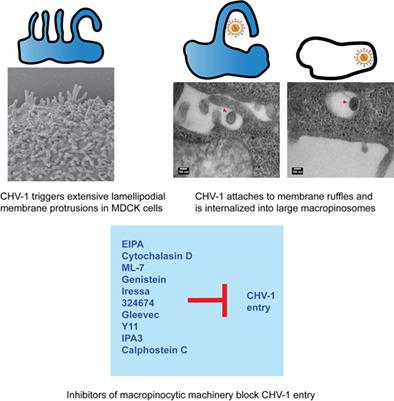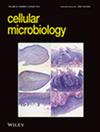Entry of the Varicellovirus Canid herpesvirus 1 into Madin–Darby canine kidney epithelial cells is pH-independent and occurs via a macropinocytosis-like mechanism but without increase in fluid uptake
Abstract
Canid herpesvirus 1 (CHV-1) is a Varicellovirus that causes self-limiting infections in adult dogs but morbidity and mortality in puppies. Using a multipronged approach, we discovered the CHV-1 entry pathway into Madin–Darby canine kidney (MDCK) epithelial cells. We found that CHV-1 triggered extensive host cell membrane lamellipodial ruffling and rapid internalisation of virions in large, uncoated vacuoles, suggestive of macropinocytosis. Treatment with inhibitors targeting key macropinocytosis factors, including inhibitors of Na+/H+ exchangers, F-actin, myosin light-chain kinase, protein kinase C, p21-activated kinase, phosphatidylinositol-3-kinase and focal adhesion kinase, significantly reduced viral replication. Moreover, the effect was restricted to exposure to the inhibitors early in infection, confirming a role for the macropinocytic machinery during entry. The profile of inhibitors also suggested a role for signalling via integrins and receptor tyrosine kinases in viral entry. In contrast, inhibitors of clathrin, caveolin, microtubules and endosomal acidification did not affect CHV-1 entry into MDCK cells. We found that the virus colocalised with the fluid-phase uptake marker dextran; however, surprisingly, CHV-1 infection did not enhance the uptake of dextran. Thus, our results indicate that CHV-1 uses a macropinocytosis-like, pH-independent entry pathway into MDCK cells, which nevertheless is not based on stimulation of fluid uptake.
Take Aways
- CHV-1 enters epithelial cells via a macropinocytosis-like mechanism.
- CHV-1 induces extensive lamellipodial ruffling.
- CHV-1 entry into MDCK cells is pH-independent.


 求助内容:
求助内容: 应助结果提醒方式:
应助结果提醒方式:


